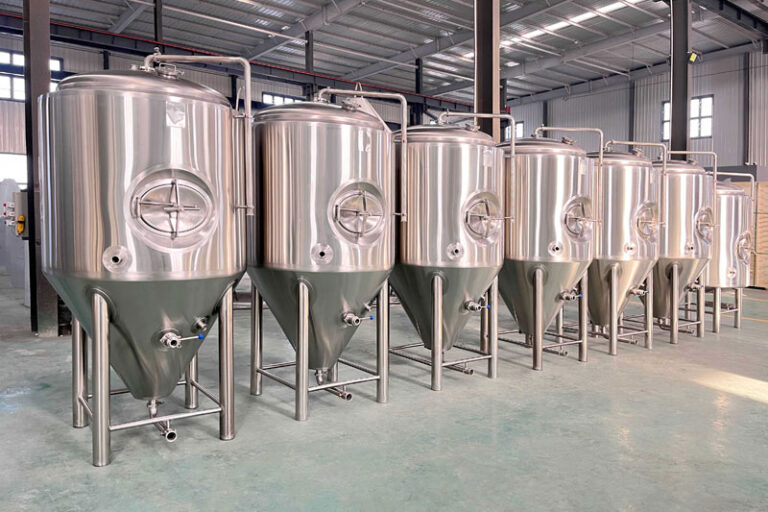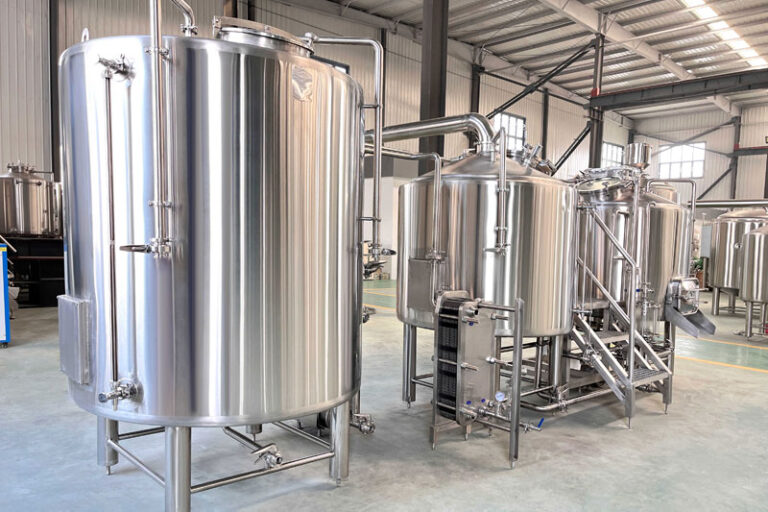As the beer brewing industry is booming, choosing the right beer brewing equipment has become the most critical step for every brewer and investor. From small-scale brewing at home to large-scale commercial production, suitable equipment is needed to achieve beer flavor and production efficiency. The quality, function, adaptability, and cost-effectiveness of the equipment not only directly affect the taste and quality of the beer, but also affect production efficiency and cost control.

Basic configuration of beer brewing equipment
brewhouse system
- Mash pot: This is the main equipment for malt mash. Malt and water are mixed in the mashpot, and the starch in the malt is converted into fermentable sugar under specific temperature and time conditions. The mash pot has heating and stirring functions, which can make the mash reaction more complete.
- Filter tank: It is used to separate the saccharified wort from the spent grains. The wort flows out through the sieve plate at the bottom of the filter tank, while the spent grains remain in the filter tank. The design of the filter tank needs to consider the filtration efficiency and the clarity of the wort.
- Boiling pot: The filtered wort is heated and boiled in the boiling pot, and auxiliary materials such as hops are added for sterilization and protein coagulation. The boiling pot usually has a strong heating capacity and stirring function to ensure that the wort is evenly heated and the hops are fully mixed.
- Spinning tank: It is used to precipitate and separate impurities such as hot coagulants and hop-spent grains after the wort is boiled. The wort rotates at a specific speed in the rotary settling tank, so that impurities settle to the bottom of the tank, thus obtaining clarified wort.
Fermentation system
- Fermentation tank: This is the main equipment for beer fermentation. The clarified wort is cooled and then added to the yeast for fermentation in the fermentation tank. The size and shape of the fermentation tank can vary depending on the scale and type of production, ranging from small laboratory tanks to large industrial fermentation tanks.
- Bright tank: It is used to store beer after fermentation and wait for filling. Clear beer tanks usually have cooling and insulation functions to keep them within the appropriate fermentation temperature range.
Refrigeration system
- Refrigeration unit: Provides the required low-temperature environment for processes such as mash, fermentation, and cooling. The performance and stability of the refrigeration unit are crucial to the quality and efficiency of beer brewing.
- Refrigerant pipes and valves: Used to transmit refrigerant and control the operation of the refrigeration system. After the refrigerant is compressed in the compressor, it dissipates heat through the condenser and is converted into liquid, which eventually reduces the temperature in the fermentation tank.
Control system
- Electrical control cabinet: Centrally control various parts of beer brewing equipment, including monitoring and adjustment of parameters such as temperature, pressure, liquid level, stirring speed, etc. The accuracy and reliability of the control system are very important to ensure the consistency and quality of beer brewing.
- Sensors and instruments: Used to measure and display various process parameters such as temperature, pressure, liquid level, etc., to provide real-time data feedback to operators.
Cleaning system
- CIP cleaning tank: Used for regular cleaning and disinfection of beer equipment. It has a certain capacity and corrosion resistance and can meet the cleaning needs of equipment of different sizes.
- Cleaning pump: Delivers cleaning fluid to various equipment parts for cleaning. It has sufficient pressure and flow to ensure the cleaning effect.
- Cleaning pipes and valves: Connect cleaning equipment and cleaned parts to control the flow direction and flow of cleaning fluid. The material is corrosion-resistant, the valve operation is flexible, and it is easy to clean.

Filling system
Filling machine: The filling machine can fill beer into containers such as bottles, cans, or barrels to realize the packaging and sales of beer.
Other auxiliary equipment
- Malt mill: used to crush barley and other grain raw materials into appropriate particle size for subsequent mash The degree of crushing needs to be adjusted according to different beer styles and brewing processes.
- Pump equipment: used to transport fluids such as wort, beer, and cleaning fluid. Choose the appropriate pump type according to different uses, such as centrifugal pumps, screw pumps, etc., to ensure transportation efficiency and reliability.
- Pipes and valves: connect various equipment components to control the flow direction and flow of fluids. The material is corrosion-resistant, the valve is flexible to operate, and it is easy to install and maintain.
Importance of choosing beer brewing equipment
- Impact on brewing quality: High-quality equipment can ensure the stability and consistency of the brewing process, which directly affects the taste and flavor of beer. Precise temperature control, good fermentation control and cleaning systems can improve product quality and ensure that each batch of beer meets the expected standards.
- Improve production efficiency: The right equipment can improve production efficiency and reduce production time and resource waste. Efficient equipment design can reduce failure rates, simplify operating procedures, and reduce production costs, thereby improving overall operational benefits.
- Meet production needs: Choosing the right equipment according to actual needs can ensure that production capacity matches the scale of the business. Whether it is home brewing or large-scale commercial brewing, the choice of beer equipment should be able to meet current and future production needs.
- Reduce long-term operating costs: Although the initial investment may be higher, high-quality equipment is usually more durable and has lower maintenance costs. In the long run, choosing efficient and reliable equipment can reduce repair and replacement costs, thereby reducing overall operating expenses.
How to choose beer brewing equipment?
- Clear brewing purpose and scale: Different needs will determine the type and specifications of the equipment. Small home beer brewing equipment is usually small in size, simple to operate, and relatively affordable. For commercial use, it is necessary to choose a larger capacity and more professional equipment to meet production needs.
- Equipment material: The material of beer brewing equipment is directly related to the quality of beer and the service life of the equipment. Stainless steel has the advantages of corrosion resistance, easy cleaning, and high strength. It is the most common material for beer brewing equipment on the market.
- Equipment function: Some equipment has a temperature control function, which can accurately control the temperature during the brewing process; some equipment has a stirring function, which can make the beer more evenly heated and fermented during the brewing process; it also has automatic control function, which can realize the full automation of the brewing process, greatly improving the brewing efficiency and quality.
- Brand and after-sales service: Choosing beer brewing equipment from a well-known brand can ensure the quality and performance of the equipment. It is also necessary to understand after-sales service, such as equipment installation, commissioning, maintenance, etc. Good after-sales can be solved in time when there is a problem with the equipment.
- Price factor: When choosing equipment, you need to choose the right equipment according to your budget. Don’t choose poor quality equipment just because it is cheap, which may affect the quality and brewing effect of beer. At the same time, don’t blindly pursue high-priced equipment, but choose cost-effective equipment according to your actual needs.

How to maintain beer brewing equipment
Maintaining beer brewing equipment is essential to maintaining production efficiency and ensuring beer quality. Here are some of the best ways to maintain equipment:
- Regular cleaning: Clean fermentation tanks, boiling pots, and other brewing equipment regularly to prevent the accumulation of yeast, hops, and malt residues; disassemble equipment parts regularly, use mild detergents and brushes to thoroughly clean each part of the equipment, and avoid using detergents containing strong acids or strong alkalis to avoid damage to the equipment.
- Regular disinfection: Use suitable disinfectants to disinfect all equipment that comes into direct contact with beer to prevent contamination and maintain the quality of beer. After disinfection, make sure to rinse thoroughly to remove any disinfectant residue.
- Inspection and maintenance: Regularly check each part of the beer equipment, such as valves, pipes, joints, etc., to ensure that they are tightly connected and leak-free. Check whether instruments such as temperature sensors and pressure sensors are accurate, and calibrate them in time if there is any deviation.
- Handling faults: Once a fault or abnormality is found in the brewing equipment, it should be stopped immediately for inspection and repair.
- Recording and monitoring: Keep detailed maintenance records, including the time and content of each cleaning, inspection, and repair. If the equipment is equipped with a monitoring system, the operating status of the equipment can be monitored in real-time to detect and solve problems promptly.
FAQ
How long does it take to start a brewery?
The timeline for manufacturing commercial craft beer equipment will depend on the details of your project scope. Micet craft professional sales team is happy to discuss your project scope and provide you with an estimate of deliverables.
Can you customize products according to customer requirements?
Yes, micet supports product customization. We are a brewery equipment manufacturing factory, so you can tell us the product requirements and our engineers will design your drawings for you.
How much should I budget for brewing equipment?
The cost of a brewery depends on a range of factors, including production scale, style, heating method, and automation level.
How is your after-sales and warranty?
Sales staff and engineers are available online 24 hours a day. Micet Craft provides a 3-year warranty on tanks sold with factory manufacturing defects and a 1-year warranty for accessories and electronic components used within the specified scope.
How long does it take to produce and deliver equipment?
Usually, our production cycle is 30-50 working days, depending on the order.
Currently, it takes 90-150 days to deliver to your door from the time we receive your deposit to delivery. Our delivery times will vary depending on the workload at our facility, but we do like to keep our delivery times honest so there are no surprises other than receiving your equipment sooner than expected.
Get a turnkey solution for brewery equipment
If you plan to open or expand the brewery, you can contact Micet Craft directly. Our engineers will design and manufacture brewery equipment according to your brewing process. Of course, we will also provide you with a complete turnkey solution. Also, if you plan to expand the brewery, we will provide you with customized solutions.

